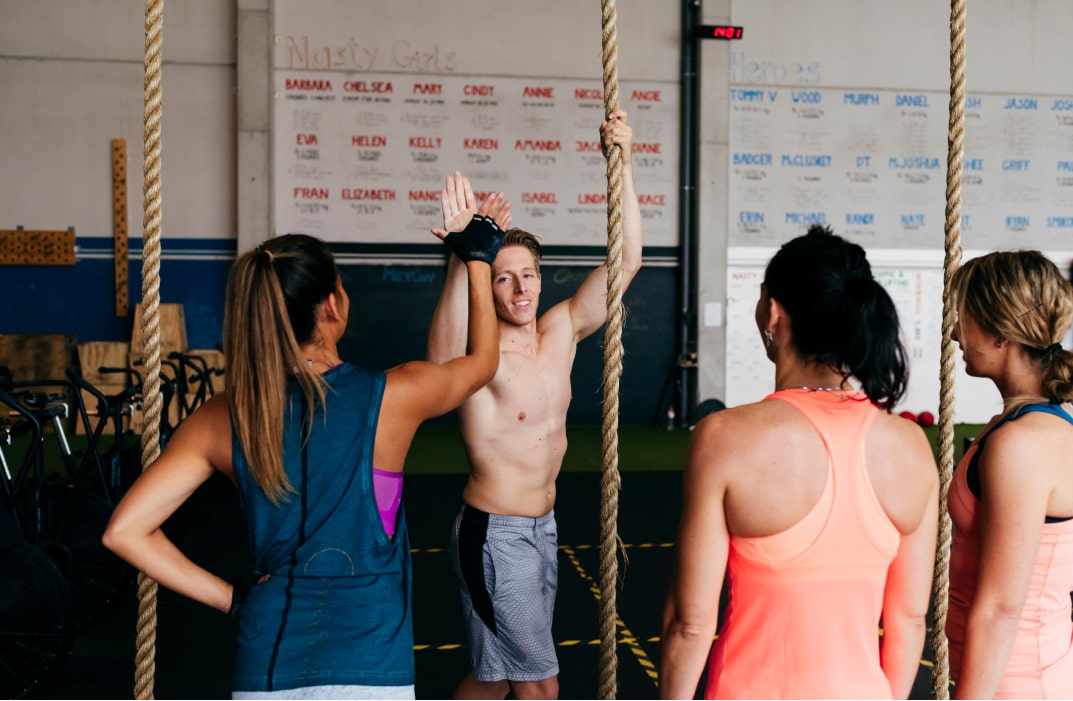Are You Earning Up to Your Potential?
Most personal trainers are undervaluing their time and skills. Our Personal trainer Revenue Calculator helps you find out what you should be making, and how to get there.
No guesswork. Just real numbers.
.jpg)
So, you’ve caught the CrossFit bug—the sweat-soaked WODs that leave you breathless, the rush of hitting a new PR, and the tight-knit community that feels more like family than just gym buddies.
Now, you’re thinking about taking that passion to the next level: opening your own CrossFit gym. Exciting? Definitely. A little intimidating? For sure. However, with the right plan, the right tools, and a strong vision, you can transform that passion into a business that not only changes your life but also makes a meaningful difference in the lives of others.
This guide will walk you through the process step by step. Whether you’re a coach with years of experience or just starting to dream about running a CrossFit affiliate, you’ll find practical advice and a clear roadmap to help you make it happen.
{{gym-name-generator-form="/blog-gym-name-generator"}}
Step 1: Understand What Makes CrossFit Unique
Before you dive into logistics, it’s essential to clarify what distinguishes a CrossFit gym from a traditional gym. CrossFit is all about constantly varied, high-intensity, functional movements. That means workouts aren’t limited to just machines or treadmills—you’ll see barbell lifts, box jumps, pull-ups, push-ups, sit-ups, kettlebell swings, thrusters, and more.
The workouts are called WODs (Workout of the Day), and they combine elements of weightlifting, gymnastics, and cardio. A single WOD might include wall ball shots, deadlifts, double unders, step-ups, and handstand push-ups. Some use a descending rep scheme, while others are structured as many rounds as possible (AMRAPs) within a set time.
CrossFit appeals to both new and advanced athletes, as workouts can be scaled to suit different fitness levels. That’s part of what makes it such a powerful model.
Step 2: Become a CrossFit Affiliate
You can’t officially call your gym “CrossFit” unless you become a licensed CrossFit affiliate. This process involves:
- Getting Certified – At minimum, you’ll need to attend the CrossFit Level 1 Trainer course.
- Applying for Affiliation – Submit your application to CrossFit HQ, including your coaching background and proposed box for CrossFit.
- Paying the Fee – There’s an annual affiliate fee (currently several thousand dollars).
- Brand Access – Once approved, you can market your business as a CrossFit gym and use the brand’s robust recognition.
The affiliate status also connects you with a global network of gyms, programming resources, and credibility that you can’t get otherwise.
💪 Got an idea for a brand? Let's bring it to life.
Launch your own fitness app with FitBudd in minutes!

💪 Got your brand name? Let’s bring it to life.
Launch your own fitness app with FitBudd in minutes!


88% trainers worldwide gave us 5 stars
Transform your fitness business with the power of your branded app on iOS and Android.
Try for FREEStep 3: Choose the Right Location

Location matters—a lot. You’ll want to strike a balance between space, access, and community. A CrossFit box doesn’t need to look like a traditional gym; in fact, many operate in industrial spaces or warehouses.
Here’s what to consider:
- Space Requirements: You’ll need open floor space for barbell lifts, squats, and intense workouts that involve a lot of movement. Plan for sufficient space to accommodate multiple athletes performing WODs simultaneously.
- Ceiling Height: Ensure you have sufficient clearance to hang rings for ring rows and rope climbs.
- Accessibility: Easy parking, public transport access, and proximity to your target audience.
- Noise: Remember, you’ll have people dropping bumper plates, blasting music, and cheering each other on.
Step 4: Invest in Equipment
One of the most significant expenses in starting a CrossFit gym is outfitting it with the right equipment. But the good news is that most CrossFit movements rely on simple, versatile gear rather than expensive machines or bulky setups. With wise choices, you can create a highly functional space without overspending.
Here’s a breakdown of must-haves:
- Barbells & Bumper Plates – For lifts like deadlifts, front squats, bench presses, thrusters, and power cleans, all of which form the backbone of strength training.
- Plyo Boxes – For box jumps, step-ups, and other explosive movements. Many gyms use foam plyo boxes or soft foam varieties to reduce injury risk and build confidence for newer athletes.
- Kettlebells & Dumbbells – Essential for swings, presses, and single-arm movements that challenge stability, coordination, and build strength.
- Pull-Up Rig – For pull-ups, muscle-ups, and gymnastics work, giving athletes the chance to master both strict and kipping movements.
- Cardio Machines – Think rowers, assault bikes, and a ski erg for conditioning and testing the cardiovascular system.
- Jump Ropes – For single unders and double unders, a staple of CrossFit cardio and coordination drills.
- Medicine Balls – For wall ball shots, sit-ups with weight, and other core-focused exercises that engage the entire body.
As your gym grows, you can expand your arsenal with specialty tools; however, this foundation will provide athletes with everything they need for complete and varied workouts.
Step 5: Design the Training Space

A good CrossFit gym isn’t cluttered—it’s functional, efficient, and inviting. The way you set up your space can influence how athletes move, train, and experience each workout. Here are some design tips to keep in mind:
- Leave plenty of space for WODs so groups can complete rounds together without feeling cramped.
- Store gear neatly with barbell racks, wall-mounted plate storage, and kettlebell racks to keep the floor clear and safe.
- Dedicate areas for gymnastics movements like handstand push-ups, ring rows, and rope climbs.
- Keep a single box or a few boxes open for step-ups, box jumps, and jump training drills.
- Provide an area for newer athletes to practice scaling movements at a slower pace, building confidence and technique before moving to advanced workouts.
The overall layout should facilitate a smooth transition from squats to pull-ups to cardio stations, maintaining a natural rhythm during workouts without athletes bumping into each other or losing focus.
Step 6: Build Your Programming
At the heart of every great CrossFit gym is innovative programming. Your goal is to challenge all fitness levels, from the athlete learning their first push-ups to the one mastering muscle-ups.
Good programming should:
- Mix strength training (squats, bench presses, front squats, deadlifts) with conditioning (row, run, bike, ski erg).
- Include gymnastics movements (ring rows, pull-ups, handstands).
- Use constantly varied routines to challenge the cardiovascular system and muscles in new ways.
- Balance high intensity with recovery days.
- Offer scale options for newer athletes while still providing a challenge for advanced athletes.
For example, a WOD could look like this:
10-minute AMRAP (as many rounds as possible):
- 10 wall ball shots
- 15 push-ups
- 20 sit-ups
- 30 single unders
Or a strength-focused session:
Descending rep scheme of thrusters and pull-ups:
- 21 reps
- 15 reps
- 9 reps
This keeps workouts exciting, effective, and scalable.
Step 7: Hire the Right Coaches
A CrossFit gym is only as strong as its coaching staff. The best coaches do far more than count reps—they motivate, correct form, build confidence, and adapt workouts to suit athletes across different fitness levels. A supportive and knowledgeable coach can be the difference between someone sticking with your gym for years and walking out after just one class.
Qualities to look for:
- Certifications – At least CrossFit Level 1, but ideally higher certifications to demonstrate more profound knowledge and credibility.
- Experience – Both personal and coaching experience matter, since coaches who’ve been through the grind themselves understand the challenges athletes face.
- Energy & Passion – They should inspire athletes to jump higher, push harder, and perform better, while maintaining a fun and encouraging atmosphere.
- Adaptability – Knowing when to push an athlete beyond their limits and when to suggest scaling back or resting is essential for both safety and progress.
Your coaches will ultimately become the face of your brand, setting the tone for classes, building relationships, and shaping the community culture—so choose wisely and invest in their growth.
Step 8: Create a Strong Community
CrossFit isn’t just about workouts—it’s about hard work, accountability, and a genuine sense of community and support. Your gym should feel more like a second home, where members feel connected, valued, and motivated to keep coming back.
Ways to build community:
- Group WODs that bring people together and create shared experiences.
- Events like competitions or charity workouts provide athletes with new goals and a reason to celebrate their progress.
- Social gatherings outside the gym, such as group meals or weekend activities, can strengthen bonds beyond training.
- Encouraging athletes to cheer each other on mid-rounds, which boosts energy and helps newer members feel included.
The sense of belonging and camaraderie is one of the biggest reasons people stick with CrossFit long-term, often valuing the friendships just as much as the fitness results.
Step 9: Marketing Your CrossFit Gym
Even the best CrossFit gym won’t grow without clever and consistent marketing. While word-of-mouth is a massive strength of the CrossFit community, you’ll still need to put in the work to get your name out there and keep classes full.
Marketing tips:
- Social Media – Post WOD videos, share member transformations, celebrate milestones, and highlight your coaches. Authentic content builds trust and shows what makes your gym unique.
- Local Outreach – Partner with nearby businesses, schools, or community events to introduce CrossFit in a friendly and approachable manner.
- Trial Classes – Offer free or low-cost sessions for individuals who want to try CrossFit. It lowers the intimidation factor and makes it easier for new faces to walk in.
- Referrals – Encourage members to bring in friends or family by offering rewards. Happy athletes spreading the word is still one of the most powerful ways to grow.
Remember, your brand is more than just a logo—it’s the energy, focus, and values your gym represents, both inside and outside the box.
Step 10: Manage the Business Side
Owning a CrossFit gym isn’t only about coaching classes and building community—it’s also about running a sustainable business behind the scenes. Strong systems and organization will free you up to focus on what you love most: helping athletes achieve their goals.
Key things to stay on top of:
- Finances – Track expenses, income, membership rates, and cash flow carefully so you can make smart decisions and plan for growth.
- Resources – Invest in reliable software for scheduling, billing, communication, and workout tracking to keep both athletes and staff organized.
- Insurance – Protect yourself, your coaches, and your athletes with comprehensive coverage in case of accidents, injuries, or property damage.
- Legalities – Obtain secure permits, contracts, and liability waivers to ensure compliance and protect your gym from unnecessary risks.
Running a gym is hard work, but using smart tools like gym crm software to organize the back end ensures long-term stability and gives you more time and energy to focus on your athletes, programming, and community.
Step 11: Prioritize Safety and Scaling
CrossFit can sometimes receive a bad reputation due to injury stories, which is why innovative programming, effective coaching, and safe scaling are so crucial. Every athlete walks in with a different background and fitness level, so offering variations helps everyone join in, stay safe, and make progress at their own pace.
Examples of scaling:
- Push-ups on knees instead of complete reps are recommended for newer athletes, as they help build strength and stability.
- Ring rows instead of pull-ups to develop pulling strength safely and effectively.
- Foam plyo boxes for safer step-ups and box jumps, reducing impact and protecting knees.
- Lower weight on barbells or use dumbbells instead of a heavy barbell for lifts like thrusters, deadlifts, or front squats.
By offering these thoughtful scaling options, you keep athletes safe while still challenging their body, core, legs, and cardiovascular system. Over time, scaled movements help build confidence, reduce the risk of injury, and prepare athletes for more advanced exercises.
Step 12: Keep Improving
Once your gym is up and running, the work doesn’t stop—never stop learning. CrossFit is built on the idea of evolution: constantly testing, adapting, and improving. That mindset applies to gym owners as much as it does to athletes. Growth, both personal and professional, is what keeps your gym relevant and thriving.
Ways to keep improving:
- Stay updated on new programming methods so your athletes consistently receive effective, varied, and engaging workouts.
- Add new equipment, such as a single box, soft foam plyo boxes, or a ski erg, to keep routines fresh and provide new challenges.
- Consider obtaining additional certifications or attending workshops to deepen your knowledge and refine your coaching skills.
- Ask for member feedback regularly to understand what’s working, what needs adjustment, and how you can further improve the community experience.
A commitment to improvement builds trust, keeps energy high, and ensures your gym remains a valuable addition to the local fitness scene—not just today, but for years to come.
Final Thoughts
Opening a CrossFit gym isn’t just about buying some weights and hanging a sign. It’s about creating a space where athletes of all fitness levels can come together, challenge themselves, and grow stronger.
From applying for CrossFit affiliate status to choosing a location, buying equipment, designing programming, and building community, you now have a roadmap.
Yes, it’s a lot of hard work. But with the right vision, you’ll build more than a gym. You’ll make a place where people come to perform, push, pull, jump, squat, and complete rounds—all while forging friendships that last a lifetime.
That’s the real beauty of CrossFit. It’s not just about muscles, reps, or even intense workouts. It’s about creating a community that thrives on focus, stability, energy, and resilience.
So, lace up, grab that barbell, and start your journey. Your future box is waiting.
Frequently Asked Questions
To start your own CrossFit gym, you need to get certified (at least CrossFit Level 1), apply and pay for a CrossFit affiliate license, secure a suitable location, buy equipment like barbells, bumper plates, plyo boxes, and rigs, and then handle the business side (insurance, permits, memberships, and marketing).
To start at a CrossFit gym as a member, sign up for an introductory or fundamentals class. Coaches will teach you the basic movements and scaling options, allowing you to join group workouts safely, regardless of your current fitness level.
The cost to open a CrossFit gym typically ranges from $30,000 to $100,000, depending on location, facility size, and equipment. This includes the CrossFit affiliate fee (approximately $3,000 annually), equipment purchases, rent, insurance, and initial marketing expenses.
Running a CrossFit gym has the potential to be profitable. Still, success ultimately depends on factors such as location, the number of members you attract, and the effectiveness of business management. Most gyms operate with relatively slim margins, and long-term profits typically come from fostering a strong community, managing costs effectively, and growing membership over time.

5 Types of Fitness Forms
Effortlessly manage client interactions with our suite of essential forms, covering every aspect of
Download Now
Templates
These functional templates have the power to make any fitness trainer's life easier.
Subscribe To
Our Blog












-1-min.jpg)













